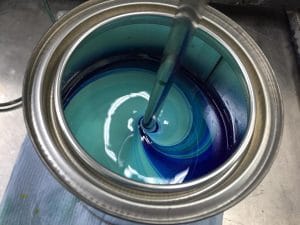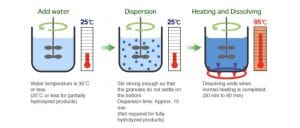Introduction
Reducing plastic consumption, resorting to a more greener lifestyle and raising environmental awareness in a worldwide perspective has transformed a lot of manufacturing companies to “go green” in their industrial processes.
For this environmental movement, it has certainly given a great deal of attention to Polyvinyl Alcohol as a contributing substance. In fact, the polyvinyl alcohol market is expected to grow at a CAGR of 4.09% for the forecast period of 2019 to 2023.
As Polyvinyl Alcohol has oxygen barrier properties, soluble in water and has biodegradability properties, it emerges as a fundamental choice for packaging material among the food packaging industry. Plus, it is also resistant to greases and oils.
Indeed, PVOH will surely trudge a long path in its future with many innovative possibilities that would require more critical and sophisticated methods and solutions in many manufacturing process that involves its use.
So as one of the greatest China Industrial Mixer manufacturer, what exactly can Ginhong provide? Read on to know what’s in store for you.
What is a PVA Solution?
Let’s start on the basics; Polyvinyl alcohol (PVOH, PVA, or PVAl) is a synthetic, water-soluble, odourless and colourless polymer that is used in many coating applications. PVOH is used in papermaking, textiles, pharmaceutics, in adhesives, paints, sealants, plastics and some cosmetic applications.
PVOH has an amazing quality of forming film effectively and has a great potential in emulsifying completely in solutions given the suitable manufacturing conditions and aspects.
It is oftentimes supplied as beads or as Polyvinyl alcohol powder or as PVA solutions in water.
What it does?
- Polyvinyl Alcohol Solution is used to strengthen yarns in textile industries.
- In Paper making, PVA solutions are used to make the paper material more durable and resilient to oils and grease.
- Used in peel-off masks as it forms a thin, transparent layer of plastic on the skin; it can be easily removed.
- Used in plastics industry in molding compounds and chemical-resistant films.
- Used to thicken the oil of many cosmetic ingredients.
- Used in making fish bait component.
- Used as a coating agent for food supplements.
- As mentioned earlier, it can be used as a green alternative for food packaging, accounting for 31.4 percent of the global share in 2016.
- PVA film is used to prevent moisture formation from foodstuff. It has crosslinking capabilities and is moisture-resistant that adds to its usability.
- For coating tablets in the medical field.
- PVA emulsions are used in making adhesives and paints.

How to make PVA Solution?
In making PVA solutions, polyvinyl alcohol powder is dissolved in water while gradually heating the solution and intensively stirring the mixture at high speed at a temperature between 90 °C to 100 °C for two hours. For this long duration of process, the end result would result be a clear and transparent PVA solution.

Image source: http://www.j-vp.co.jp/english/product/pva/use.html
Avoiding water evaporation is needed to maintain the consistency of the solution, so a condenser can be used to lower the temperature.
Now that we have covered the basics in making PVA solutions from powders and water, let’s dig deeper into the technicalities of making PVA solutions in a macro industrial perspective.
The Process of Mixing PVA Powders in Mixtures
PVA can be dissolved in hot or cold water. Tap water is a preferred solvent in making PVA solutions as bacterial mitigation may form in distilled water.
A solution would typically be prepared as follows:
- Slowly stir in a specific amount of polyvinyl alcohol powder into a known volume of cold water. Do not add the powder rapidly as it may clump and form a sticky mass as temperature rises.
- When the powder is fully dispersed, heat the mixture to a temperature of 90 °C to 100 °C at which the polymer becomes solubilized.
- Continue mixing until the PVA is entirely solubilized and emulsified. The grade of material and efficiency of agitation can affect the rate of solubilization and emulsification.
The Problem with Conventional Polyvinyl Alcohol Solution Mixers
Using conventional mixers and agitators, a number of problems can be encountered during production:
- Difficulty in breaking down lumps and a longer mixing time is required for solubilization.
- Dispersion of the PVA powders becomes difficult as the viscosity starts to rise.
- Presence of undissolved substances or agglomerates and impurities due to lack of mixing power.
- Longer mixing time due to difficulty in hydrating ingredients.
- The vigorous agitation required to wet out the powder can lead to aeration problems.
- A high degree of shear is needed to hasten the mixing process.
- Additional heating equipment can be costly.
The Solution to Efficiently Mix PVA Solutions
Ginhong mixer can effectively disperse and solubilize the powders of PVA in water at an inherently fast rate. The procedure is as follows:
- The high-speed rotation of the rotor creates a powerful suction, drawing the powdered PVA and other ingredients into the workhead.
- A central motor drives the shaft in the mixing tank. This shaft is coupled with an impeller which it is rotated at a high-speed, driving oils and PVA powders with strong centrifugal force. The mixer incorporates a high fluid shear inside the tank to emulsify and homogenize the material.
- The intake and expulsion of materials through the workhead ensures that the contents of the vessel passes many times through the workhead. The combination of heat, vigorous mixing and particle size reduction accelerates the melting process of the ingredients, and rapidly disperses the powder grinds into the oil to produce a homogeneous end product.
- In this way, the PVA solution mixer rapidly accelerates the solubilization process, hydrates the thickening and stabilizing agents, break down the remaining agglomerates, and finely reduce particle and globule size forming stable emulsions and suspensions.
Advantages of Ginhong Mixers
Optimized Yield of Ingredients
Powder is entirely dispersed even before the viscosity rises. Fully dispersed PVA powders and emulsified PVA solution.
Dramatic Reduction of Processing Time
Heating stage is eliminated as hot water is added to dissolve PVA.
Less Air Entrainment
Mixing unit performs in a controlled, closed-loop system, reducing the probability of air entrainment that causes cavitation or formation of bubbles in a liquid.
Fast Inherent Reaction Rates
Intense and enhanced chemical reaction with high degree of concentrated input energy that produce superior dispersion than traditional mixing methods.
Agglomerates can be easily dissolved by the high shear, accelerating solubilization.
Stable Emulsion
Ginhong PVA Solution Mixer can make uniform and homogeneous emulsion, with good physical and chemical properties.
Reduced Waste and Sanitary
The scraper gathers material wastes which can be collected without process interruption.
Consistent Product Quality and Stability
Offers batch-to-batch product consistency and stability with high manufacturing savings.
VIDEOS:
LZ-80 vacuum concentric dual shaft mixer for making fastener coatings
Vacuum planetary mixing machinery for sealants and adhesives
